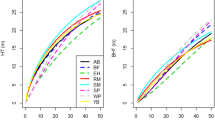Abstract
Two models, Carbware (CW) and Growfor (GF), of different resolution and based on different frameworks were evaluated in relation to stand-level forecasts of volume and basal area using Ireland’s National Forest Inventory (NFI) data. CW is a distance-independent single-tree model that is based on diameter increment. GF is a stand-level dynamic empirical model that uses the von Bertalanffy–Richards growth equation in a state-space framework. NFI data were used as input to the models, and each model’s projections were compared to NFI data at the next measurement cycle. The NFI is a permanent sampling system with the objective to assess the composition and extent of the forest estate. A subset of the NFI was used in the study, single-species even-aged plots comprising Sitka spruce and lodgepole pine. The accuracy and performance of the CW and GF models were analysed using residual analysis and standard statistical techniques. Results show that both models require improvement, though the study has raised concerns regarding the suitability of the NFI data for this type of investigation.





Similar content being viewed by others
References
Arabatzis AA, Gregoire TG (1990) Ordered and un-ordered multinomial response models: an application to assess loblolly pine merchantability. Can J For Res 21:261–268
Black K (2016) Description, calibration and validation of the CARBWARE single-tree-based stand simulator. Forestry 89:55–68. doi:10.1093/forestry/cpv033
Broad L, Lynch T (2006) Growth models for Sitka spruce in Ireland. Ir For 63:53–79
Burnham KP, Anderson DR (2002) Model selection and multimodel inference. Springer, Berlin, Heidelberg
Duffy P, Hyde B, Hanley E, O’Brien P, Ponzi J, Black K (2013) National inventory report Greenhouse gas emissions 1990–2011 Reported to the United Nation Framework Convention on Climate Change
Edwards PM, Christie JM (1981) Yield models for forest management. Forestry Commission Booklet 48. HMSO
Garcia O (1981) Simplified method-of-moments estimation for the Weibull Distribution. NZ J For Sci 11:304–306
García O (1984) New class of growth models for even-aged stands—Pinus radiata in Golden Downs forest. NZ J For Sci 14:65–88
García O (2011) A parsimonious dynamic stand model for interior spruce in British Columbia. For Sci 57:265–280
García O, Ruiz F (2003) A growth model for eucalypt in Galicia, Spain. For Ecol Manag 173:49–62. doi:10.1016/S0378-1127(01)00817-9
García O, Burkhart HE, Amateis RL (2011) A biologically-consistent stand growth model for loblolly pine in the Piedmont physiographic region, USA. For Ecol Manag 262:2035–2041. doi:10.1016/j.foreco.2011.08.047
Härkönen S, Mäkinen A, Tokola T, Rasinmäki J, Kalliovirta J (2010) Evaluation of forest growth simulators with NFI permanent sample plot data from Finland. For Ecol Manag 259:573–582. doi:10.1016/j.foreco.2009.11.015
Hasenauer H (2006) The tree growth model MOSES 3.0. In: Hasenauer H (ed) Sustainable forest management. Springer, Berlin, Heidelberg, pp 64–70
Hawkins M, Black K, Connolly J (2012) Validating generalised diameter-height models for several species and heterogeneous crop structures. Ir For 69:58–72
Huber MO et al (2013) Comparing simulations of three conceptually different forest models with National Forest Inventory data. Environ Model Softw 40:88–97. doi:10.1016/j.envsoft.2012.08.003
Irish Forest Service (2016) Irish Forest Species. http://www.agriculture.gov.ie/forestservice/publications. Accessed 20 June 2016
McCullagh A (2013) Development of dynamic yield models for conifers, broadleaves and mixtures in Ireland. Dissertation, University College Dublin
McCullagh A, Hawkins M, Broad L, Nieuwenhuis M (2013) A comparison of two yield forecasting methods in Ireland. Ir For 70:7–17
Monserud RA, Sterba H (1996) A basal area increment model for individual trees growing in even- and uneven-aged forest stands in Austria. For Ecol Manag 80:57–80. doi:10.1016/0378-1127(95)03638-5
Newnham RM (1964) The development of a stand model for Douglas-fir. Dissertation. University of British Columbia
NFI (2007) The National Forest Inventory—Republic of Ireland. Forest Service, Dublin
NFI (2013) The Second National Forest Inventory—Republic of Ireland. Forest Service, Dublin
Nieuwenhuis M, Malone L, McHugh F, Layton T (1999) Development and evaluation of a pre-harvest inventory and cross-cutting simulation procedure to maximise value recovery. Ir For 56:12–28
Pretzsch H (2009) Forest dynamics, growth and yield from measurement to model. Springer, Berlin, Heidelberg
R Development Core Team (2014) R: a language and environment for statistical computing. R Foundation for Statistical Computing, Vienna
Salas C, García O (2006) Modelling height development of mature Nothofagus obliqua. For Ecol Manag 229:1–6. doi:10.1016/j.foreco.2006.04.015
Soares P, Tomé M, Skovsgaard JP, Vanclay JK (1995) Evaluating a growth model for forest management using continuous forest inventory data. For Ecol Manag 71:251–265. doi:10.1016/0378-1127(94)06105-R
Thürig E, Kaufmann E, Frisullo R, Bugmann H (2005) Evaluation of the growth function of an empirical forest scenario model. For Ecol Manag 204:51–66. doi:10.1016/j.forceo.2004.07.070
Vanclay JK (1994) Modelling forest growth and yield. CAB International, Wallingford
Wykoff WR (1990) A basal area increment model for individual conifers in the northern Rocky Mountains. For Sci 36:1077–1104
Zeide B (1993) Analysis of growth equations. For Sci 39:594–616
Acknowledgements
The BETTERFOR project was funded by the Competitive Forestry Research for Development (COFORD) in the Department of Agriculture, Food and the Marine (DAFM).
Author information
Authors and Affiliations
Corresponding author
Additional information
Communicated by Arne Nothdurft.
Rights and permissions
About this article
Cite this article
McCullagh, A., Black, K. & Nieuwenhuis, M. Evaluation of tree and stand-level growth models using national forest inventory data. Eur J Forest Res 136, 251–258 (2017). https://doi.org/10.1007/s10342-017-1025-8
Received:
Revised:
Accepted:
Published:
Issue Date:
DOI: https://doi.org/10.1007/s10342-017-1025-8



